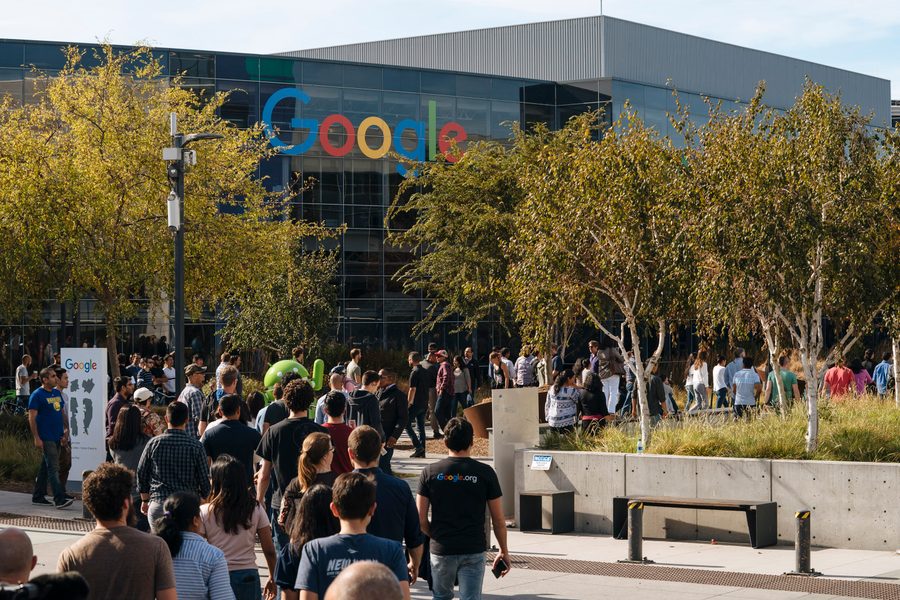Google Workers Say the Endless Wait to Unionize Big Tech Is Over
“You have a union when you say you have a union.”
Hamilton Nolan

The five most valuable companies in America are all big tech companies, and none of them are unionized. Compounding this existential challenge for organized labor is the fact that the huge work forces of the companies make unionizing them seem an impossibly large task. Now, one union has solved that problem with a revolutionary approach: Just start.
This morning, workers at Alphabet, the parent company of Google, announced the formation of the Alphabet Workers Union (AWU), affiliated with the Communications Workers of America, one of the few major unions that has dedicated resources to organizing the tech industry. The AWU is starting with just over 200 members — a tiny fraction of the more than 200,000 total Google employees, including full timers and contractors, that make up the $1.2 trillion company. But, after years of isolated issue-based activism by employees, they realized that if they ever wanted a union, the only way to get it was to forge ahead.
“A lot of us joined the company because we believed in the values. That wasn’t a secondary thing, that was why we joined,” says Chewy Shaw, a Google software engineer since 2013 who is now the vice chair of the AWU. Shaw describes a slow souring of his relationship with the company in recent years, as workers perceived as troublesome were pushed out by hostile management, and others chose to leave over sharp ethical disagreements about the company’s direction. The internal uproar last year over Google’s contracts with government agencies like ICE was a clarifying moment for Shaw, who decided that if he was going to stay at the company, he had to start organizing.
Since the 2018 Google walkouts protesting sexual harassment (and the subsequent retaliation against its organizers), Google has been the most high profile hotbed of worker organizing among the big tech companies — though all of that organizing focused on specific issues as they arose, rather than on forming a union. Shaw began attending events that employees set up related to organizing: a luncheon, a book club, a lecture. Eventually, he connected with CWA staff and began actual labor organizing in earnest. Last June, a group called Googlers Against Racism got more than 1,000 employee signatures on a Coworker.org petition urging the company to take a number of steps to promote diversity and end contracts with police. That group provided a pool of interested activist workers that led directly to discussions about unionizing, and to recruits for the union. Shaw says that the firing last month of Timnit Gebru, an internal critic of the company, was “a really big rallying moment.”
(In response to today’s news, the company said in a statement: “We’ve always worked hard to create a supportive and rewarding workplace for our workforce. Of course our employees have protected labor rights that we support. But as we’ve always done, we’ll continue engaging directly with all our employees.”)
Google is a company of engineers, and if there’s one thing engineers understand, it’s structural issues. After the 2018 walkout, “it became clear to me that it wasn’t enough. We weren’t able to move the company the way it needed to be moved,” says Auni Ahsan, a software engineer and one of the union’s founding members. “We need a structure that we can develop that can be resilient.”
Shaw scoffs at the longstanding canard that engineers are constitutionally hostile to labor organizing, an idea that has often been floated within both the labor and tech worlds to explain why the tech industry remains largely non-union. “People are at a company that has organized 250,000 people to work on similar projects,” he notes drily. As Google employees have worked with CWA to build their union, they have also been studying labor history and American labor law, and their diagnosis of the weaknesses in today’s labor movement has helped inform their path. “We’ve been thinking some of [the decline of unions] is due to how people have been leaning on the legal structure, and it doesn’t give enough protection unless you fit a specific scenario,” Shaw says.
The AWU’s structure could be a model for future tech organizing. It will be a dues-supported organization, like a union, but it will be open to both full time employees and contractors, who make up more than half of Google’s work force. The union has been organizing in secret, meaning that much of its recruitment work was restricted to the social networks of its various employee organizers. They decided to go public after claiming 200 members, and they hope that the rush of publicity will bring in thousands of more members in short order. AWU will not be able to engage in formal collective bargaining like a union that represents the entire staff, but it will be a permanent, growing, and very vocal labor group positioned squarely inside one of the world’s most powerful companies — something that would have been virtually impossible if CWA had tried to follow a traditional union organizing route within Google.
“Thousands or millions of people will wake up and see this story and see that you don’t need to wait for the labor board to approve your union,” Ahsan says. “You have a union when you say you have a union.”
Hamilton Nolan is a labor writer for In These Times. He has spent the past decade writing about labor and politics for Gawker, Splinter, The Guardian, and elsewhere. More of his work is on Substack.








